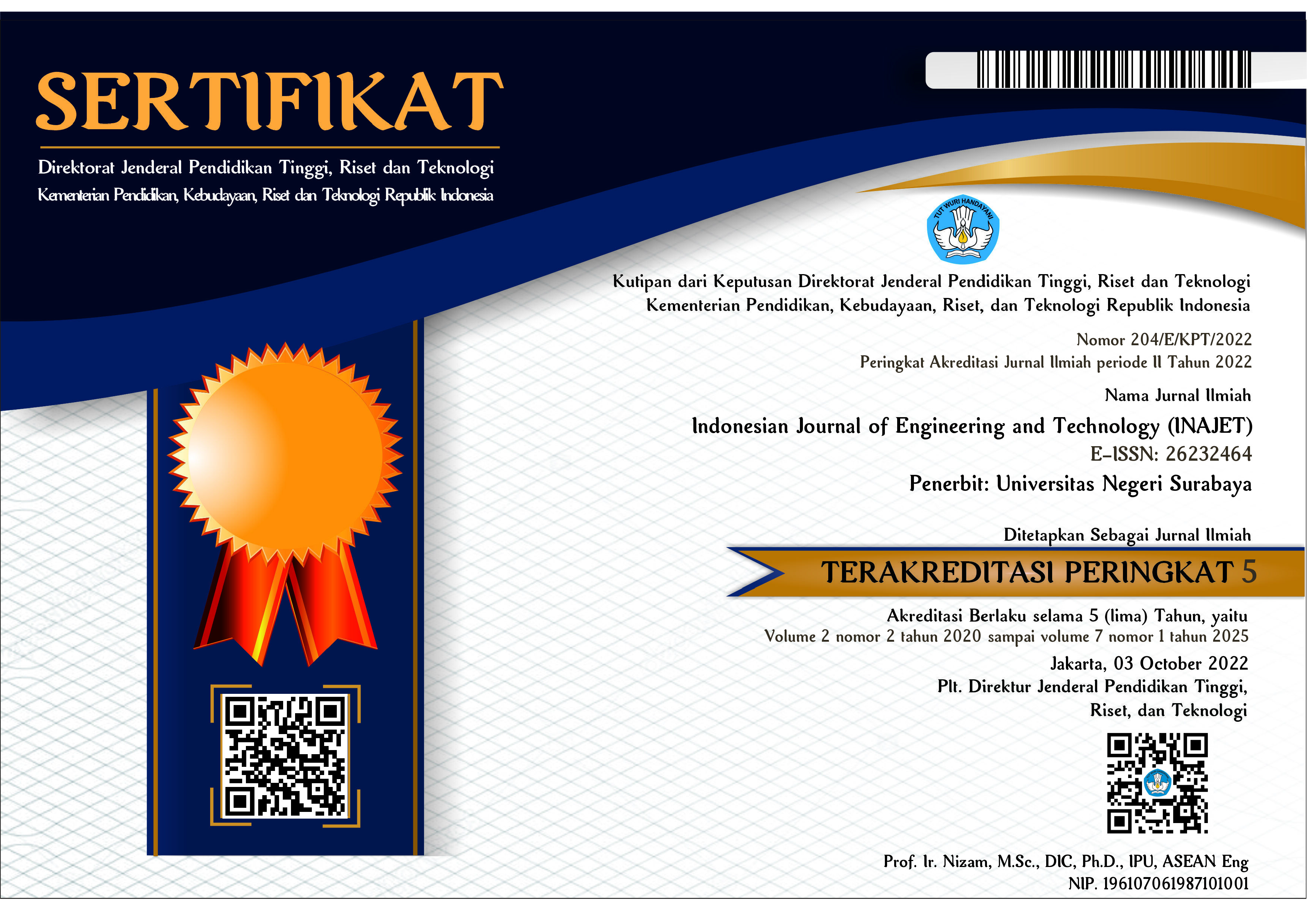IMPROVED POWER GRID STABILITY WITH REGULAR MAINTENANCE OF MEDIUM-VOLTAGE TRANSFORMER CONNECTIONS
DOI:
https://doi.org/10.26740/inajet.v8n1.p41-49Keywords:
Transformer connection, Power grid stability, Routine maintenance, Voltage qualityAbstract
The power grid is a vital infrastructure that ensures the distribution of energy from the plant to the consumer. One of the important components in this network is the transformer, which regulates the voltage level as needed. In medium-voltage networks, transformer connections play a crucial role in maintaining system stability. Unmaintained connection conditions can cause disturbances in the form of decreased voltage quality, blackouts, and equipment damage. Unfortunately, connection maintenance is often done reactively, only when a fault occurs. This study aims to analyze the impact of routine maintenance of transformer connections on the stability of the power grid at PT PLN (Persero) UP3 South Surabaya – ULP Ngagel. The methods used include field observation, documentation of maintenance activities, and analysis of disturbance data before and after maintenance. The results of the study show that routine maintenance is able to reduce the frequency of connection failures, improve voltage stability, and extend the life of network components.
References
Abaza, A. et al. (2025) ‘Optimal parameter extraction of equivalent circuits for single- and three- phase Power transformers based on arctic puffin algorithm accomplished with experimental verification’, Results in Engineering, 26(February). Available at: https://doi.org/10.1016/j.rineng.2025.104888.
Alabdullh, M. k. k. et al. (2024) ‘A novel method to estimate the lifetime of mineral oil-type power transformers based on the analysis of chemical and physical indicators using artificial intelligence’, Heliyon, 10(22), p. e40447. Available at: https://doi.org/10.1016/j.heliyon.2024.e40447.
Feng, Y. et al. (2025) ‘Case Studies in Thermal Engineering A method for monitoring internal temperature field distribution of transformers based on heat transfer coefficient under different operating conditions’, Case Studies in Thermal Engineering, 75(September), p. 107094. Available at: https://doi.org/10.1016/j.csite.2025.107094.
Hu, H. et al. (2023) ‘Transformer-customer relationship identification for low-voltage distribution networks based on joint optimization of voltage silhouette coefficient and power loss coefficient’, Electric Power Systems Research, 216(November 2022), p. 109070. Available at: https://doi.org/10.1016/j.epsr.2022.109070.
Islam, N. et al. (2023) ‘Power transformer health condition evaluation: A deep generative model aided intelligent framework’, Electric Power Systems Research, 218(February), p. 109201. Available at: https://doi.org/10.1016/j.epsr.2023.109201.
Lee, H. Il and Kim, J.W. (2025) ‘Hybrid multi-encoder transformer and case-based reasoning for intelligent decision support in high-speed railway vehicle maintenance’, Knowledge-Based Systems, 325(March), p. 113943. Available at: https://doi.org/10.1016/j.knosys.2025.113943.
Li, Q. et al. (2026) ‘Real time state evaluation method for transformers based on health index and cloud model’, Electric Power Systems Research, 250(July 2025), p. 112134. Available at: https://doi.org/10.1016/j.epsr.2025.112134.
Prasojo, R.A. et al. (2025) ‘Sustainable Energy , Grids and Networks Enhanced maintenance prioritization strategies for medium voltage distribution substations through precise health index assessment’, 44(September).
Qiao, X. et al. (2025) ‘Study on the mechanism of horizontally striped contamination distribution along the surface of dry-type transformers and its influence on electric field characteristics’, International Journal of Electrical Power and Energy Systems, 166(February), p. 110542. Available at: https://doi.org/10.1016/j.ijepes.2025.110542.
Vatsa, A. and Hati, A.S. (2024) ‘Insulation aging condition assessment of transformer in the visual domain based on SE-CNN’, Engineering Applications of Artificial Intelligence, 128(July 2023), p. 107409. Available at: https://doi.org/10.1016/j.engappai.2023.107409.
Wang, F. et al. (2025) ‘Prediction of three-dimensional temperature and current density field distribution in solid oxide electrolysis cells by modified transformer’, Energy Conversion and Management: X, 27(June), p. 101187. Available at: https://doi.org/10.1016/j.ecmx.2025.101187.
Zahra, S.T. et al. (2025) ‘Power transformer health index and life span assessment: A comprehensive review of conventional and machine learning based approaches’, Engineering Applications of Artificial Intelligence, 139(PA), p. 109474. Available at: https://doi.org/10.1016/j.engappai.2024.109474.
Zhang, R. et al. (2025) ‘Interpretable prediction of multi-photovoltaic power stations via spatial-temporal multi-task learning with Transformer-XLSTM’, Results in Engineering, 28(September), p. 107369. Available at: https://doi.org/10.1016/j.rineng.2025.107369.
Zhang, X.K. et al. (2021) ‘Analysis and optimization about electromagnetics-temperature-component distribution in calcium carbide electric furnace’, Applied Thermal Engineering, 185(May 2020), p. 115980. Available at: https://doi.org/10.1016/j.applthermaleng.2020.115980.
Zhang, X.K. et al. (2022) ‘The study of heat-mass transfer characteristics and multi-objective optimization on electric arc furnace’, Applied Energy, 317(April), p. 119147. Available at: https://doi.org/10.1016/j.apenergy.2022.119147.
Zuñiga, J. et al. (2024) ‘Methodology for the optimal replacement of power transformers based on their health index’, Electric Power Systems Research, 234(April). Available at: https://doi.org/10.1016/j.epsr.2024.110582.
Downloads
Published
How to Cite
Issue
Section
 Abstract views: 69
,
Abstract views: 69
, PDF Downloads: 59
PDF Downloads: 59











